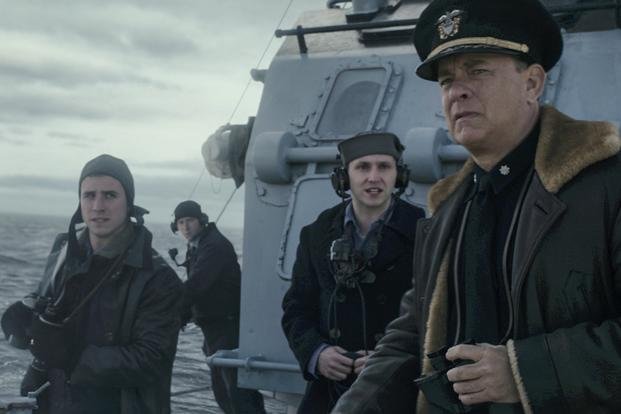"Greyhound" offers a very narrow slice of World War II combat and aims to tell its story in a way that allows its sailors to stand in for the millions of men who fought during that war. Coming in at a very tight 82 minutes before credits, the film focuses on the perils of battle and how the men respond to combat.
Written by and starring Tom Hanks, "Greyhound" was set to be a big theatrical release from Sony Pictures over Father's Day weekend. Then Hanks and wife Rita Wilson became the first famous people we knew to become ill from the COVID-19 virus, movie theaters closed and everyone went into quarantine.
Rather than wait for an as-yet-unknown date in the future for theaters to reopen, Sony and Hanks decided to sell the movie to the fledgling Apple TV+ service, and the film debuts July 10. Surprisingly, the Apple TV app is available on Roku and many smart TVs, so there's a good chance you've got access even if you don't have an Apple TV device.
The Apple TV+ service costs $4.99/month after a seven-day free trial. It may not be as overrun with content as its competitors, but a one-month subscription is a lot cheaper than the $19.99 rentals that seem to be the standard for most Hollywood movies that have bypassed theaters and gone straight to home video this spring.
The choice to go with Apple TV+ might have seemed risky a couple of months ago, but theaters are nowhere near reopening for major releases and even that Dec. 23 release date for "Top Gun: Maverick" is starting to look a bit shaky. "Greyhound" offers a much-needed dose of new entertainment.
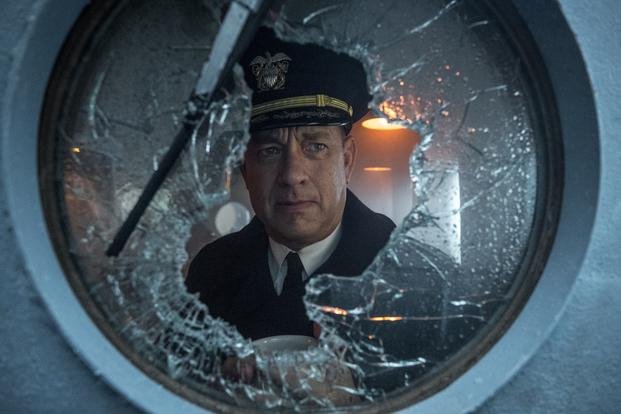
Hanks based his screenplay on C.S. Forester's 1955 novel "The Good Shepherd," one of the author's less-famous works but one that has long enjoyed a cult following in U.S. Navy circles.
Ernie Krause is a man who's waited too long for his own command and, when he finally gets one, he's assigned the task of protecting a convoy across the Atlantic in 1942 against German U-boats determined to take as many casualties as possible.
After the briefest of introductions to Krause, we join the convoy as it's leaving the air cover zone off the Atlantic coast and stay with it for the two days it must survive until British air cover can pick it up on the other side of the journey.
The movie focuses on the tasks at hand and is loaded with Navy jargon that Hanks somehow makes work as coherent dialogue that should make sense even for those who know nothing about World War II combat ships. No one gets a backstory. Everyone's there to carry out a mission, and character is revealed in how each man carries out his duties.
That puts "Greyhound" at odds with almost every major WWII movie made since "The Longest Day" in 1962. Hanks is interested in the job at hand and how the burden wears on Capt. Krause. Extraneous subplots about romances back home or troubled father-son relationships would just distract from the real story.
Director Aaron Schneider made use of the USS Kidd, a WWII-era Fletcher-class destroyer now preserved as a museum ship berthed on the Mississippi River at Baton Rouge, Louisiana. The ship was used for interior locations, and the production built a simulated bridge on a gimbal at a studio location nearby.
All of the water, planes, other ships and U-boats in the movie were created by CGI, and the execution shows just how rapidly technology is developing. It's a step up from what we saw last fall in "Midway" and, since the most compelling action takes place inside the ship and on the faces of its men, the effects don't distract from the story.
"Greyhound" shares DNA with WWII B-movies made in the late '40s and '50s, the ones where actors, script and director came together to make something a lot better than the double-picture filler the studios thought they were making. TCM viewers will know what I mean. "Greyhound" is like those war movies the network shows between 3 a.m. and noon, the ones you hadn't heard of before but are really glad you watched when they're over.
No one's getting together for individual, on-camera interviews these days, so Apple set up online press conferences for Hanks and Schneider last week. Lots of our friends from the international press wanted to know about Tom vs. the pandemic, but both the writer/star and director managed to share some interesting insights into their new movie.
Why "The Good Shepherd"?
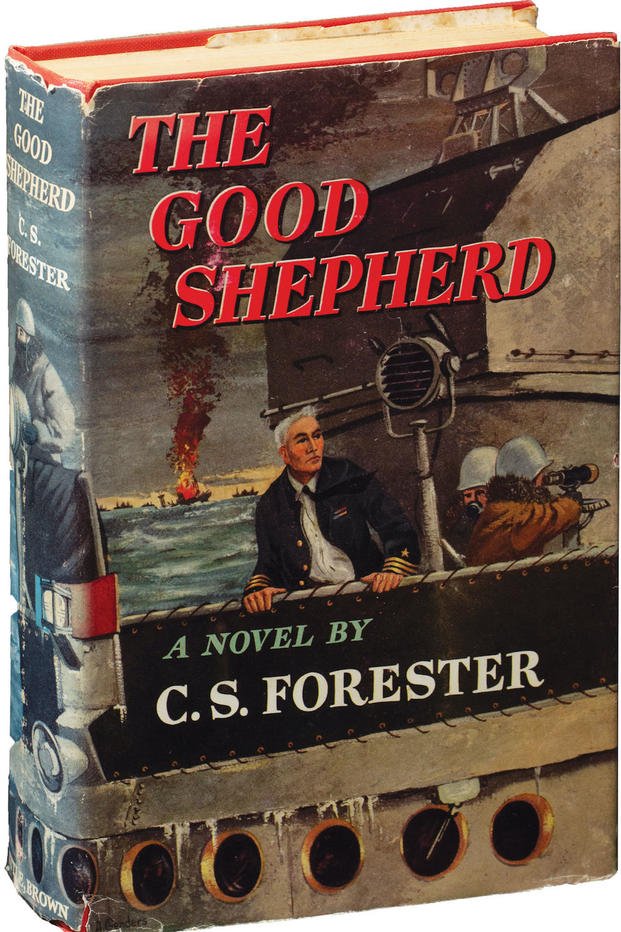
Tom Hanks: Seven or eight years ago, I bought a used copy of C.S. Forester's "The Good Shepherd." I was attracted to it because the book had its original cover. It was an image of Ernie Krause, gray-haired, undone, exhausted, uniform flapping in the wind, a ship sinking and burning on the horizon as one of his crewmen is tapping out a signal.
And I thought: That man is exhausted. That man has been through a degree of hell. I have a bit of historical knowledge about the Battle of the Atlantic, which this book is obviously a part of. So I picked it up just because I read history for pleasure.
By the time I got to page three, I realized that this was an entire story told through the mental perspective of its protagonist. Ernie Krause is not the captain that you would anticipate being in charge of the safety of all these ships. Not long after that, I had a very, very strong mental image of the DNA of the story and, as a selfish actor, how it could be a screenplay of a movie.
I want to play great roles. As a guy who goes back to World War II again and again, I see direct correlations to life as it is lived right now. I see the same questions being asked and I see the same solutions being pursued in stories of World War II, despite them being period pieces that recreate a past world.
To me, it's always been about what would we do if we were in those same circumstances, and guess what? We are in many of those same circumstances right now. That began a seven-year process of adapting the book to my own ends. When I was doing the writing, I just put in stuff that I and I alone wanted to see in a movie because I had never quite seen them before.
Historical accuracy
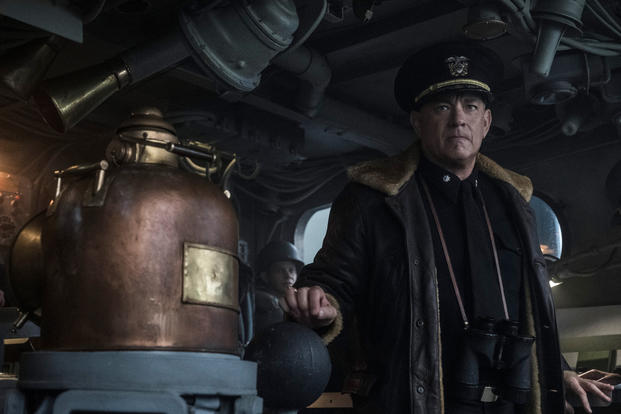
Aaron Schneider: When I came on board, the first thing I did was make sure that I was completely caught up in the authenticity and the research. I put together a website. I wanted to make sure that I could share all the research with my crew once they came on board. I had a little time during prep.
I collected imagery and YouTube links and all kinds of stuff from depth charges to uniforms, to procedure, to the onboard analog computers and submerged myself in that whole world. So
I wanted to find interesting ways to not just tell the story on the page, but also tell the story of the destroyer and the equipment they use, which is a big part of understanding and appreciating the dedication and the hard work that goes into the sailors' lives.
The challenge in making movies about the U.S. Navy
Tom Hanks: Both as a film buff and as a guy who reads and pursues history for pleasure, Navy films almost always disappointed me. In the 1950s, movies like "Run Silent, Run Deep" or "The Enemy Below" or "In Harm's Way" could only do so much just because of the relatively primitive aspects of filmmaking techniques. What you had in them was really great characters.
I must confess that most of our populace's understanding of naval strategy and protocol really came from the Starship Enterprise and Capt. James T. Kirk. "Mr. Sulu, you have the con," showing the order of a chain of command.
Here's the thing about a fabulous movie like "The Enemy Below" with Robert Mitchum and Curt Jurgens. It's one-on-one: A destroyer, a submarine, something that's atypical of the experience, certainly in the battle of the Atlantic convoys, where you had multiple ships, all turning in different speeds, the chaos.
"The Enemy Below" focused literally on mano-a-mano, a chess game between two fabulous performers, good technology. But if you take a look at it, all those guys on those Navy ships, they're much older than they were in World War II. They all look like they're 35 when, in fact, the average age of enlisted men was 22, 24 years old. They're all much younger guys. That movie is a real gem but, much like the World War II movie as a genre, it was limited by the technology of the time it was made.
The technology behind the movie
Aaron Schneider: I looked into whether it was feasible to film at sea. We found our main location in a museum ship called the USS Kidd down in Louisiana. It's a highly preserved World War II ship. In fact, it's the only World War II destroyer that's still in its World War II configuration. A lot of them got modified in the Vietnam war and the wars that followed.
The USS Kidd was restored back to its condition after it was hit by a kamikaze in 1945. The museum takes a lot of pride in the ship, and it was a perfect starting point to ground the film in authenticity and reality.
Once we chose the ship, we built a set on a gimbal for the pilothouse, since a lot of the movie takes place on the bridge. We matched that set in Louisiana to the museum ship, so that we could then subdivide the film into where we needed the control on the set and when we wanted to incorporate guns and more of the ship.
I always felt it was a little bit like a cowboy movie. You can't make a western without the horse, you know? A western's about that close-up of the cowboy, but his horse is a big part of the story. When we wanted to incorporate the destroyer into the visual language of the film, we moved that scene or a piece of it over to the museum ship. Since the set was matched to the museum ship, we were able to give the impression that we were kind of grounded in the reality of this authentic World War II museum ship.
We looked into the feasibility of pulling a ship out into the water for some work, but that's very logistically difficult on our budget and schedule. It was a quick movie shot in about 35 days.
The water you see in the film is 100% CG when we're looking out over the water at some of the submarines and other ships. Of course, when we're in the pilothouse doing more intimate close-up work, the water outside that was background in window replacement.
Before the shoot, I flew down to the Kidd, brought a couple of cameras and took about 10,000 photos of that ship. We used photogrammetry software. If you throw a bunch of photos at it, put them inside of a program, press a button. Tons of time later, you end up with a sort of a high-resolution visual model. It's a little bit like LIDAR scanning, if you're familiar with that.
I turned it into this sort of high-res model of the ship that I was then able inside to use a 3D program to look around and explore. Between photographing literally every inch of that ship and spending the time that I did in this software program to study this virtual model of the ship, I got to know pretty much every nook and cranny of it.
Of course, in a 3D package like that, you can put in the camera you're using and the lens you're using, and you can even start to experiment with visuals. When we built the gimballed set that was based on the Kidd, we were able to experiment with how much more room we could cheat ourselves.
On being the oldest guy on the set
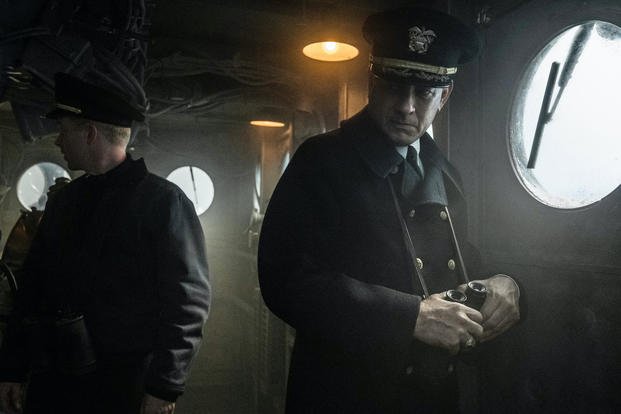
Tom Hanks: I'll be 64 years old on June 9. I think I can play a guy who's 48, 50, 52 years old. But I'm an older guy. I can play a career naval officer who was about to retire, but because of America's entrance into the war, his expertise is required.
Theoretically, I can play that guy. Not only that, I have, in my own realm, the same questions of veracity and ability as Ernie Krauss does. I know that truth. Let me explore that. Let me put on his mantle and eliminate those insecurities that we all have.
Aaron Schneider and everybody on casting, we said these guys need to be young because they were young. I think the oldest guy on the ship along with Ernie Krause is Charlie Cole (played by the great Stephen Graham), the doctor and Rob Morgan, who plays a career mess mate in a segregated Navy.
They are maybe peers with Krause, but everybody else wasn't much older than 24 years old. With the young actors that we cast, we trusted them from the get-go to learn the procedures, to come in with an idea of their characters and then provide these beats that were not in the screenplay. Without them, we don't have a fully-rounded or illuminated movie. We needed that young thing.
We were on a very small set. It's a very small space. I actually get to move around a lot. The only other actors who got to move around with me were the guys playing the talkers, the guys with the big helmets and the microphones and the headphones. They had to follow me. Everybody else had to stand in one place for the entire scene.
They understood that and ended up adding not only drama and cinema to the choreography, but they also brought their characters to it. At the end of the day, moviemaking is, on one hand, this goofy racket where you're putting on clothes that are not your own and pretending to be somebody else.
What also has to go along with that is that you have to go there. You can't fake it. You actually have to be there in a psychological way and not just physically. We had a fantastic group.
These young faces in helmets and caps were the authentic crew that is younger than anybody else. We couldn't have picked a better cast of young actors who were dedicated in order to make that happen.
Keep Up With the Best in Military Entertainment
Whether you're looking for news and entertainment, thinking of joining the military or keeping up with military life and benefits, Military.com has you covered. Subscribe to the Military.com newsletter to have military news, updates and resources delivered straight to your inbox.
